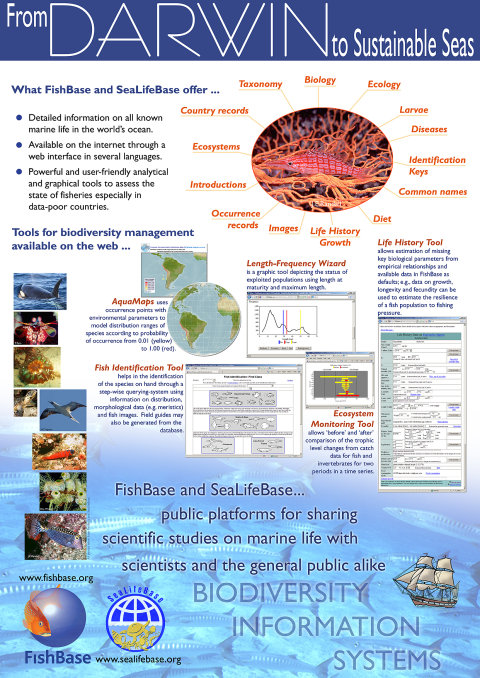Poster 4: Biodiversity information systems
FishBase and SeaLifeBase are public, web-based, global archives of published data on nomeclatural, geographic, biological, ecological and traditional knowledge on aquatic organisms.
 Created some 20 years ago to support fisheries management with sound scientific knowledge, FishBase has evolved into a biodiversity information system on all fishes on earth (roughly 31,000 species). With more than one million visits per month on the web, it serves many user groups for different purposes through interfaces in 21 languages and 8 mirror sites.
Created some 20 years ago to support fisheries management with sound scientific knowledge, FishBase has evolved into a biodiversity information system on all fishes on earth (roughly 31,000 species). With more than one million visits per month on the web, it serves many user groups for different purposes through interfaces in 21 languages and 8 mirror sites.
AquaMaps uses occurrence points with environmental parameters to model distribution ranges of species according to probability of occurrence from 0.01-1.00;
The Fish Identification tool helps in the identification of the species on hand through a step-wise querying system using information on distribution, morphological data (e.g., meristics) and fish images. Field guides may also be generated using this structure.
The Ecosystem Monitoring tool allows ‘before’ and ‘after’ comparisons of the trophic level changes from catch data for fish and invertebrates for two periods in a time series.
The Life History tool allows estimation of missing key biological parameters from existing data. It gives an idea of a fish species or population’s resilience to fishing pressure.
The Length-Frequency wizard provides a graphic representation of the status of exploitation of a population.
The much younger SeaLifeBase, built using the FishBase platform in 2006, is attempting to duplicate the FishBase feat for non-fish marine organisms of all the earth’s oceans. Supported with FishBase’s 20 years of expertise and Catalogue of Life’s authoritative taxonomic backbone, enhanced by the World Register of Marine Species, SeaLifeBase was able to collect information for more than 80,000 marine organisms within its first 2 years.
Both FishBase and SeaLifeBase maintain networks of almost 2,000 collaborators worldwide. As data providers, both information systems contribute to many international initiatives and national programmes, for example, the Catalogue of Life, the Barcode of Life, the Encyclopedia of Life, GenBank, the IUCN, the Sea Around Us Project and many others.
FishBase is piloted and SeaLifeBase is endorsed by an international consortium of 9 institutions:
- Muséum National d’Histoire Naturelle, Paris, France;
- Musée Royal de l’Afrique Centrale, Tervuren, Belgium;
- Swedish Museum of Natural History, Stockholm, Sweden;
- Institut für Meereskunde, Kiel, Germany;
- the WorldFish Center, Los Baños, Philippines;
- FAO, Rome, Italy;
- the Fisheries Centre of the University of British Columbia, Vancouver, Canada;
- School of Biology in the Department of Zoology, Aristotle University, Thessaloniki, Greece;
- Chinese Academy of Fisheries Science, Beijing, China.
The financial support for the development stages of FishBase came from the European Commission.








